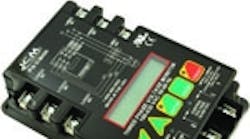Commercial refrigeration product manufacturers aren’t sitting around waiting for something good to happen in the U.S. economy. They’re continuing to bring new product ideas to the drawing board, and are turning those ideas into refrigeration solutions for contractors and their customers.
From compressors to controllers to purification, systems innovation is far from a deep freeze. ContractingBusiness.com spoke with some of the leaders in commercial refrigeration manufacturing to learn about the innovative products they’re offering contractors in 2010. These products that offer increased efficiency, accuracy, and protection for customers seeking the best of what’s available.
Compressor protection controls are key components in commercial refrigeration. “You don’t want to lose a compressor due to a low voltage or undervoltage situation. You must protect the compressor as best as you can,” says Ron Kadah, president ICM Controls, Syracuse, NY. “The ICM450 provides front- and back-side protection.”
Plug-in is the new range of Carel controllers for static or ventilated refrigeration units operating at normal or low temperatures. Carel, an Italy-based company, has a U.S. office in Manheim, PA.
Sources say Plug-in provides the manufacturer with advanced electronics, high performance in the control of refrigeration units, custom design solutions and a reduction in production costs. New Plug-in models can directly manage compressors of up to 2 Hp.
These represent the response to market requirements for applications in which there is the need to reduce the number of electrical components in the refrigerating appliance to reduce costs, assembly times and component management.
HVAC and refrigeration engineers have long searched for a cost effective sensors capable of monitoring the refrigerant temperature in condenser and evaporator coils. In these applications, the only suitable place to mount the sensor is on the coil return bend, which makes sensor attachment a very difficult design problem. The Sens-A-Coil by Spectrum Sensors & Controls, St. Marys, PA, integrates a fast response thermistor element into a plastic, overmolded copper clip, designed to snap onto 3/8-in. return bends.
The sensor is housed in a small bulb attached to the copper clips, and the Sens-A-Coil maximizes sensing surface area. “This enables the sensing element to quickly react to any changes in the refrigerant temperature,”says Devin Brock, director of sales and marketing.
Additionally, according to Brock, new California energy standards will require that a saturation temperature sensor must be part of the system once it’s installed, so that the refrigerant temperature can be verified by third party raters.
“Commercial refrigeration customers are looking for ways to reduce refrigerant charge, as a way to reduce refrigerant system leaks,” acknowledges Rajan Rajendran, director, engineering services for the refrigeration division of Emerson Climate Technologies.
“Reducing refrigerant charge invariably goes hand-in-hand with reducing refrigerant leaks,” continues Rajendran. “In that regard, refrigerant racks are the incumbent technology, which seem to be giving way to secondary systems and distributed systems, which I think will grow over the next few years. Their lower charge implies lower leak rates and a lower carbon footprint. And while doing all of this, you don’t want to sacrifice efficiency. ‘Green’ should mean lower GWP and efficiency. Digital technology has been successfully adapted to compressor technology. A recent example is Emerson’s Copeland Scroll Digital™ and Copeland Discus Digital™ compressors, which Emerson sources say provide a new level of capacity modulation.
“Previously, rack systems were designed evenly, to keep things simple; but at times, you also had to design uneven systems, to provide enough steps in capacity to match the variations in supermarket loads,” explains Kurt Knapke, manager of supermarket and electronics programs for Emerson’s refrigeration division.
“With digital compressors, you can design a rack with even compressors, and provide sufficient capacity modulation capabilities by having continuous digital unloading on one compressor. That simplifies your rack design, allows for easier serviceability, and could potentially reduce the first cost of the rack system, by eliminating a compressor off of the rack. You’ll also see performance benefits based on matching that capacity being generated to the actual required load in the store. You’ll see a tighter suction pressure control, resulting in tighter control of case temperatures, which will help extend food shrinkage and/or shelf life. “Additionally, by controlling the digital compressor as the lead compressor and ramping it up and down throughout its modulation range, you don’t have as many compressors cycling on and off. That results in less energy use and reduced wear and tear on the equipment.”
The quality and purity of ice must be protected. The Ice-UV from Fresh-Aire UV, Jupiter, FL, kills mold and other microbes before they become established, reducing the need for machine maintenance“Last year, the American Society of Heating, Refrigerating, and Air-Conditioning Enginees (ASHRAE) recognized the benefits of UV light technology,” says Ron Saunders, vice president, sales for Fresh-Aire UV, a division of Triatomic. “Engineers are developing new, commercial UV light applications to keep systems free of microbial growth, and to improve system performance without requiring chemicals for cleaning.”











